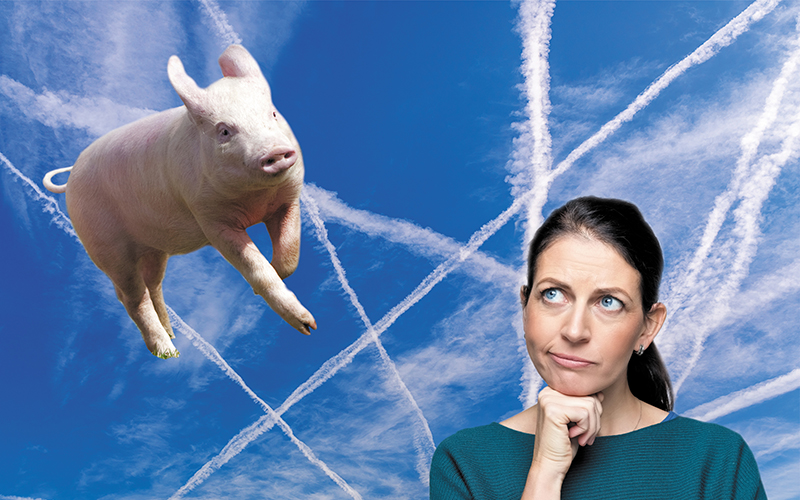Pigs might fly: Australian aviations delusional emissions future
February 18, 2024
Australian aviation is in the news again. Having ripped off passengers, illegally sacked workers, and impacted the health of residents under airport flight paths, the industry has now received $30m from taxpayers to manufacture sustainable aviation fuel (SAF). And investors and airlines are clamouring for more.
Having committed to net zero emissions by 2050, or Net Zero 2050, (Aviation Green Paper, p.1) the federal government says SAF will help maximise aviations contribution (Aviation Green Paper, p.73).
So, yes. Pigs might fly. Literally and metaphorically.
Literally as pig fat in SAF. And metaphorically because the governments emissions reduction proposals for aviation can never make flying climate safe.
SAF wont allow the planet to cool. SAF wont make flight emissions net zero by 2050. And Net Zero 2050 wont prevent 2C of warming.
SAF wont allow the planet to cool
2C of warming will likely trigger life-as-we-know-it-ending consequences. For an acceptable chance of avoiding them, according to leading climate scientists, we need to do three things, and aviation has a role in two of them. Right now, new emissions need to be cut to near absolute zero at emergency speed to prevent increased warming. At the same time, we need to draw down the CO2 already in the atmosphere to cool a dangerously hot planet. The last time CO2 in the atmosphere was as high as now 420 ppm warming hit 3C and sea levels ended up 10 metres higher.
We need to stop the warming and start the cooling.
Our government, however, is trapped in the delusion that cooling can be ignored, that drawing down CO2 can safely allow new CO2 emissions. This delusion has a name. Its called Net Zero 2050. And the CO2 reduction claims for Sustainable Aviation Fuel ride on its coat tails.
SAF wont make flight emissions net zero by 2050
SAF, when burnt, emits the same amount of CO2 as jet diesel, not less. The claimed reduction, compared to jet diesel CO2 emissions, is achieved when CO2 drawn down in growing the SAF feedstock whether pig or plant is subtracted from in-flight emissions. SAFs lifecycle CO2 emissions (growing through to burning) are less than jet diesels. In this way SAF CO2 emissions can be said to be net zero. As such SAF is then marketed as clean, green, sustainable and eco-friendly despite preventing cooling.
Even if we ignore the priority of cooling, its delusional to think SAF can make flight emissions net zero by 2050.
Firstly, because SAF can only claim net zero for CO2 flight emissions. While non-CO2 emissions, including nitrous oxides and contrail cirrus, for a given flight, contribute twice the warming of CO2 alone (Aviation Green Paper, p.78), and cant be drawn down.
Secondly, in practice, for Australian aviation to get to net zero CO2 emissions, 100% SAF would be required to fuel all flights. Yet, the size of the financial investment and land acquisition required to grow the feedstock, then manufacture and deploy it to all flights 20 billion litres by 2050 will, the government agrees, be prohibitive.
Federal transport minister, Catherine King (Aviation Green Paper, p.38), says offsetting will therefore be needed to help make CO2 flight emissions net zero by 2050. But her colleague, federal climate minister, Chris Bowen, disagrees. He has specifically ruled out the use of offsets across the transport sector under Safeguard Mechanism regulations to achieve emissions reductions of 43% by 2030 on the way to NZ2050.
Offsetting allows a tonne of new CO2 flight emissions right now, on the premise that another tonne will be drawn down somewhere, some time later. But in practice that rarely happens. And even when it does it still prevents cooling.
Net zero 2050 wont prevent 2C of warming
Underlying the governments projected future for Australian aviation sits the delusion that 2C of warming will be prevented if CO2 emissions get to net zero by 2050.
Emissions reduction proposals, like NZ2050, should have a near zero risk of failure as we require for the infrastructure we build given the threat that 2C represents. Yet the IPCC acknowledges a risk of failure for Net Zero 2050 that most would find unacceptable. Warming in 2023 has already nudged 1.5C. It will hit 2C by the 2040s if significant policy changes are not made, according to current climate models. Indeed, former NASA climate chief James Hansen recently warned that global warming of 2C will be reached by the late 2030s.
On current plans, the UN reports annual new emissions globally will be no lower in 2050 than they are today. With our government planning for a threefold increase in flights by 2050 (Aviation Green Paper, p.96) actual flight emissions from Australian aviation wont be dropping either.
In summary, Australian aviation policy is based on these three delusions. In reality, for a chance of holding warming to 2C, all emissions need to be reduced at emergency speed. And, because flying is the fastest way to fry the planet, the only way aviation emissions can be cut at the speed required, is by regulating flight reductions to near zero by 2030.
Were facing the abyss. And our government is telling us we can fly. So will we jump?
